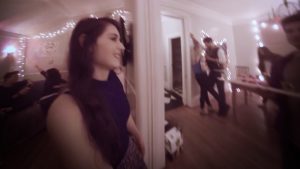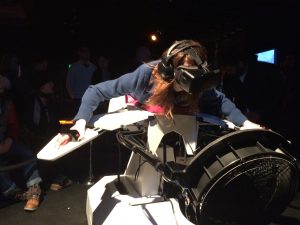Sundance 2015 – New Frontier Kicks Reality Up a Notch

Senior producer Maddy Kadish examines the convergence of tech and new film forms at New Frontier.
Park City, UTAH — Given the slow march of the film industry away from the in-person movie theatre experience, New Frontier rapidly becomes more important every year. New Frontier offers a reason to pause the movie you’re watching on Netflix, get out of your house, and come to the theatre — or, in this case, Sundance’s showroom for virtual reality and other art installations.
New Frontier, established in 2007, is Sundance’s vision of the future of film. It exhibits the best of the convergence of film, art, media, live performance, music, and technology and takes the form of art installations, panel discussions, and films. This year New Frontier offered a plethora of virtual reality, gaming, choose your own adventure, and other types of interactive storytelling experiences with over 13 exhibits that spanned two floors of its location on Main Street in Park City. New Frontier was free and open to the public.
“The technology is constantly changing,” said filmmaker and Sundance staff member Daniel Foerste as he showed me the exhibits, most of which were the “Developers Kit” (DK) versions. This means that in spite of being the very latest work by the artist (and/or software developer), by the time it’s out on the floor, Foerste explained, the technology is “already out-dated.”
After covering New Frontier and other similar festival forays for years, noticeable at Sundance was the purposeful use of technology among the exhibits. From using virtual reality to be a child in a Syrian refugee camp to using an interactive movie to see how the same script can play out in very different ways, technology put the audience in the driver’s seat and personalized the diverse stories.
In Perspective: Chapter 1: The Party, the audience, or user, experiences a narrative story from the point of view of each character by wearing virtual reality (VR) goggles. A party fills with kegs, red cups, and college-age people acting like idiots.

Users play the roles of an intoxicated young woman and man, hearing the same dialogue in the same situations, but from the other’s point of view. Perspective addresses the subject of date rape, a complex issue that has been receiving a lot of media traction, and one that poses a challenge for the writers in developing a meaningful and realistic script. The piece is a partnership of Rose Troche, writer/director/producer of films such as Go Fish and The Safety of Objects, and Morris May, a visual artist and founder of Specular Theory, a virtual reality production studio.
Putting on the VR goggles makes the work more than just a “he said, she said” — you see and feel what happens to your vision and balance when you have had too much to drink. I began by wearing the VR goggles of the young man. When I watched the scenario again with the VR goggles of the young woman, it took me a few minutes to realize who I had been before – a skinny, insecure kid. The VR demonstrated not only the damage that can be done in a situation like this, but also brought sober gravity to the term beer goggles.

Assent, a beautifully composed and personal VR from Chilean artist Oscar Raby, immersed us into Raby’s father’s experience with the Chilean Army death squad (“Caravan of Death” campaign) following the coup of 1973. Raby constructed the narration to put users in the point of view of his father. Rather than calling up explicit war images in the VR goggles, Raby used art, sound, and the Chilean landscape to convey his story.
The sensitive work of VR “gets under your skin,” said Shari Frilot, co-director and senior programmer for New Frontier, over the din of New Frontier attendees. “As an exhibitor, we worked with the artists to develop a platform, [or] an exhibit space around the VR, so that there is a social environment for their work to reduce the [user’s] anxiety, and space to decompress afterwards. The platform provides cues related to what you will experience in the VR.” For Assent the exhibit space was the bedroom of a teenage boy, complete with dirty laundry lying around and punk rock posters. The space made it easy to imagine a teenage boy coming to grips with his father’s difficult past. The space around Perspective conveyed that of a college dorm or apartment: a bed, a tattered sofa, and an empty keg surround you as you don the goggles.
Project Syria is a VR piece by journalist Nonny de la Peña, who partnered with technologist Palmer Luckey on Hunger in Los Angeles at the 2012 Sundance Film Festival. Project Syria was commissioned by the World Economic Forum to focus on the experience of children in a refugee camp as they flee their homeland. Rather than sitting on a bed, a sofa, or a desk chair, as in the space of Assent or Perspective, here one enters a nondescript camp to experience the VR. I felt a sense of vulnerability when I put on the VR goggles, particularly while walking. When the reality of the Sundance exhibit space disappeared I could surrender to the virtual environment.
Birdly, by Max Rheiner, took the concept of trust further as it both visually and physically immersed the user. Birdly users lie in a flight simulator contraption. Their arms become wings and he or she plays the role of a bird flying over San Francisco. The contraption tilts and lifts you as a fan blows air at you. One fellow user described it as a “carnival ride for one person.” The VR-contraption combo generated the feeling of the height, speed, and sound of flying, as you sail by the buildings and billboards in San Francisco.

New Frontier showed us that even non-VR works can muster reality. In Possibilia, an interactive narrative short film about a couple breaking up, users select different options, via thumbnail images at the bottom of an iPad screen, to create different ways that the break-up plays out, all with the same script. Possibilia stars Zoe Jarman (The Mindy Project) and the Alex Karpovsky (Girls) and was directed by Daniel Scheinert and Daniel Kwan, known for their visual effects-driven work. If it seems like Karpovsky is everywhere on the indie scene, in Possibilia, he literally is. Multiple versions of the characters spin out as the user makes different choices and we see countless Alex Karpovsky’s and Zoe Jarmon’s in the same image. As the story unfolds, each one seamlessly steps back into its place, coming together into one character again in a beautiful and elegant motion. Possibilia premiered at the 2014 Tribeca Film Festival.
“There are so many possibilities to explore character and narrative in this format,” said Rebecca Webb, New Frontier attendee and Film Curator of Filmatic Festival, a festival dedicated to exploring the future of film and the evolving ways in which we consume and create media. “With so much competing media, audiences expectations are high. Good storytelling is still critical, but audiences no longer want to be passive consumers.”
“I hope people get involved with immersive storytelling – and observe themselves reacting to it,” Frilot said. “This is not technology taking over, but [how with] artistic vision [and] technology, the storyteller is an expansion of humanity.” It was clear from the large crowds, yet again this year, that New Frontier had something important to add to that ever-changing exploration.
Regions: United States, Utah
